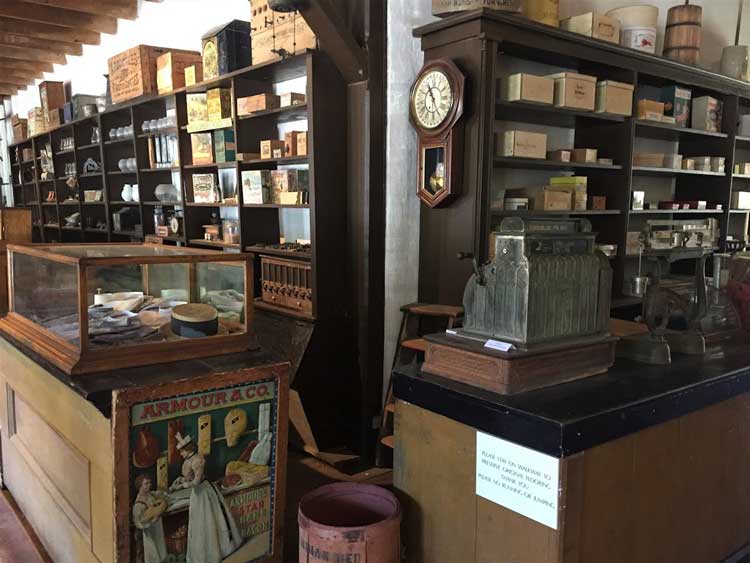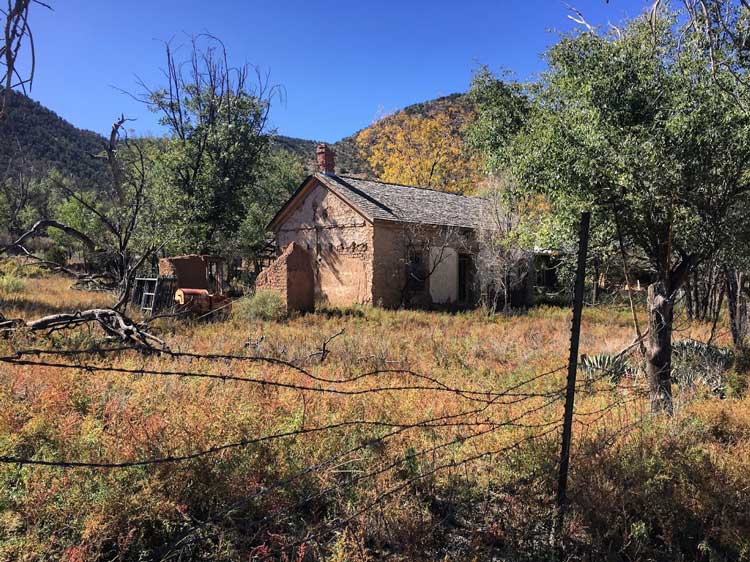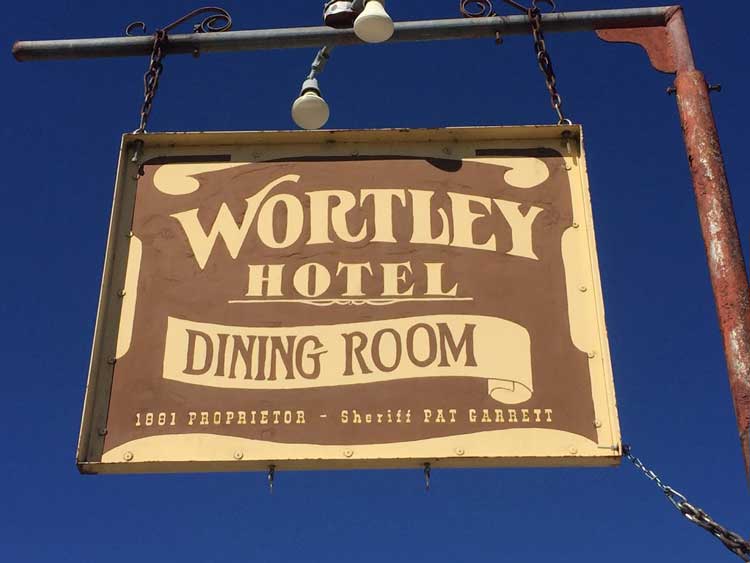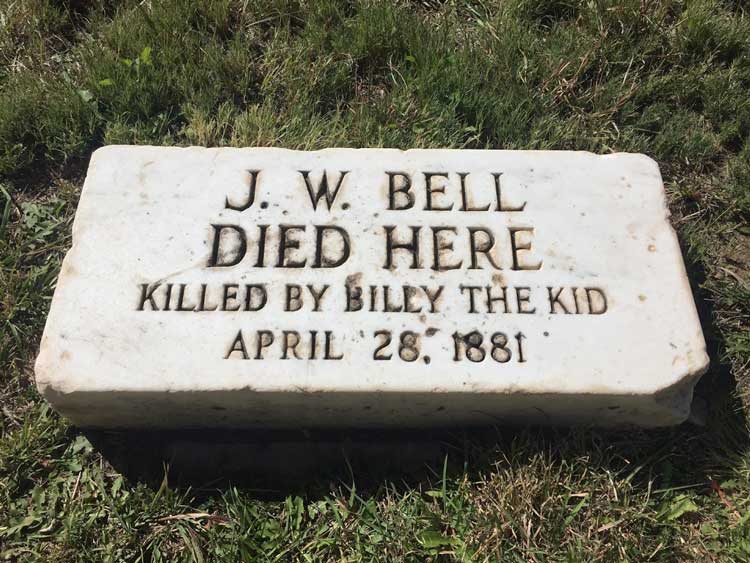
It’s hard to pinpoint the attraction of Billy the Kid. Viewed in one light, he probably was a psychopath who gunned down a sheriff and two (maybe three) deputies in cold blood, as well as some other assorted enemies.
He was an outlaw, a rustler, a hired gun and a murderer who was himself shot dead at the age of just 21 in a dark room without even firing his own gun.
And yet… whenever you’re dealing with Billy the Kid, there’s always an “and yet.” Even his enemies admitted he was personable.

At just 5-foot 7-inches and 135 pounds, he could look like a good-natured young kid who loved to dance and drink, played the violin, and always had a wide grin. Women were attracted to him.
While it’s true he did kill a sheriff, the fact is the sheriff was crooked and under the control of a gang that had murdered Billy’s mentor and friend. And yes, he killed two deputies escaping from jail, but the deputies were going to hang him, a sentence many felt was unjust.
BILLY THE KID IN LINCOLN, NEW MEXICO
There’s one thing everyone can agree on: Billy the Kid became famous. You can’t fire a six-shooter in Lincoln County, New Mexico, without hitting something named after him. There are Billy the Kid motels, restaurants, souvenir shops and even a casino. Google him and there are 142 million entries.
The official national scenic byway through Lincoln County is named after him. The only known tintype photo of him sold in 2011 for $2.3 million, making it one of the most valuable photos in the world.
In his lifetime, there were articles written about The Kid as far away as New York, and he’s been portrayed in 50 movies by actors such as Roy Rogers, Paul Newman, Kris Kristofferson, Val Kilmer and Emilio Estevez.
Even in Vienna, Austria, you can order a “Billy the Kid” hamburger (“Der Wilde Kerl”) at the Weinschenke restaurant, and everyone knows who you’re talking about.
So what’s the real story about Billy? Well, there’s no better place to find out than Lincoln, N.M.
THE BILLY THE KID NATIONAL SCENIC BYWAY
The town of Lincoln in south-central New Mexico is the focal point of the 84-mile Billy the Kid National Scenic Byway. The circular byway passes over grassy plains, through dense pine forests, past ranches and horse farms, through old towns nestled at the base of snowcapped peaks and across wild rivers as it connects a land associated with outlaws, Apaches, gunfights, Buffalo Soldiers and, of course, Billy the Kid.
There’s no place more fascinating along the way than the town of Lincoln, which is virtually unchanged from the way it looked in the 1870s. The one street of the town is lined with two dozen historic buildings.
A few of them hold gift shops and cafes, and there is a brewery, but this is no flashy tourist town, and there’s little to indicate you’re even in the 21st century. Pull up to the Anderson Freeman Museum & Visitor Center, mosey over to the adobe building and watch a 10-minute film that sets the stage.
THE LINCOLN COUNTY WAR
In 1878, Lincoln County, N.M. was the largest county in the U.S. – an area the size of Ireland. And policing it was just one sheriff, William J. Brady. The real power was held by a couple of Irish partners, J.J. Dolan and John J. Riley.
They owned a giant mercantile store in the town known as “The House.” Through crooked supply contracts with nearby Fort Stanton and by selling stolen cattle from Mexico, the Irish partners had amassed a fortune.

The idea of muscling in on some of the huge profits being earned by “The House” looked appealing, if maybe a little dangerous, to a wealthy Englishman, John H. Tunstall, and his Scottish lawyer/partner, Alexander McSween. So they opened their own mercantile shop, the Tunstall Store, across the street from the “House.” It was an uneasy competition from the beginning; both sides hired gunmen for protection.
Into this volatile situation rode Billy the Kid. He was perhaps born as Henry McCarty in New York in 1859 and came west to New Mexico with his mother, who died when he was 14. Alone, he ran with a rough group of rustlers and was known variously as Kid Antrim and William H. Bonney.
At 18 in Arizona, he got in a tussle with a bully who was tormenting him. The Kid jerked his revolver and shot the bully dead. Since the bully was unarmed, the Kid was convicted of murder. Instead, he escaped from jail, drifted into New Mexico, and ended up working for Tunstall as a hired gun.
The Englishmen liked him, and said, “That’s the finest lad I ever met….I’m going to make a man out of that boy.”
Unfortunately, the arrangement did not last long. “The House” trumped-up charges on Tunstall and sent Sheriff Brady with a posse to arrest him. In the process, Tunstall was murdered with a bullet in the chest and another in the back of his head.
The Kid swore revenge.

He formed the other McSween men into a gang called “The Regulators.” Billy was fond of Dime Novel Westerns that were just appearing at this time, and ironically, he might have gotten the idea for the name “The Regulators” from one of these early “shoot ‘em up” romances.
But shoot ‘em up they did. In a short time, two of the posse members suspected of murdering Tunstall were themselves murdered, and Billy was about to become a legend.
THE MOST DANGEROUS STREET IN AMERICA
As you leave the museum, it’s a 200-foot walk west to the Tunstall Store. Walk through the door and you’re back to 1877. Everything looks perfect. The shelves are lined with tins of coffee and bags of beans. The floorboards creak.
McSween’s 240-volume law office is down on the west end and Tunstall’s living quarters are in the east end, behind the Post Office. The Kid would have known this store well, and would certainly recognize it today.
It was in the alley beside this store that the Lincoln County War escalated. The Kid and five friends happened to be in this alley when, by chance, Sheriff Brady and a deputy walked by.
Without warning, the Kid and his gang opened fire. If you walk across the street, you can see stone markers along the sidewalk where Brady and his deputy were hit and lay on the ground, bleeding and dying.
THE BEGINNING OF THE END
Billy the Kid’s vengeance was just beginning. Continue walking down the north side of the street to the next vacant lot. This was the site of the lavish McSween House. On the night of July 14, 1878, fearing he would be murdered like his partner Tunstall, McSween gathered 50 or 60 armed Regulators including the Kid and stationed them in this house and in other buildings around town.
Across the street, the Irishmen gathered all the gunmen supporting the “House,” and placed them in other buildings and rooftops. For the next five days, all hell broke out and a literal war was fought between the two factions, with hundreds of bullets flying across the street.
Finally, the Irish Dolan & Riley gang set fire to the McSween House. Fighting from smoke-filled rooms, Billy convinced McSween to make a run a for it, and with guns blazing, the Kid led the remaining Regulators out. In the confusion, McSween was shot and killed, but The Kid gunned down his murderer and then made his escape.
The story made national news and U.S. President Rutherford B. Hayes called Lincoln’s main street, the “Most dangerous street in America.”

$500 REWARD – DEAD OR ALIVE
With both his employers dead, Billy became an outlaw. In the end, 22 men would be killed during the Lincoln County War, a half dozen or so by the Kid. To stop further violence, the governor of New Mexico (former Civil War Gen. Lew Wallace) stepped in and offered everyone pardons. Everyone, except Billy the Kid. Billy was exempt because there was a warrant out for him before the “war” started for killing Sheriff Brady.
Billy was incensed and wrote a letter to Gov. Wallace agreeing to testify against the killers of a local Lincoln lawyer in exchange for a pardon. Incredibly, the governor actually agreed to meet him.
Look across the street from the former site of the McSween house and you can see what today is a private residence, but back in 1879 was the site of the Lupe Cisneros House. Here, in March 1879, Gov. Wallace held a secret meeting with Billy the Kid.
The Kid arrived wearing a six-shooter and carrying a Winchester rifle. The governor consented to give Billy a pardon if he turned himself in and testified. Billy did both, but the Dolan & Riley gang still controlled Lincoln County.
Once Billy was in jail, they refused to let him out. So he escaped again! But this time with a $500 price on his head.

SHERIFF PAT GARRETT ARRIVES ON THE SCENE
Continue walking west down Lincoln’s main street and in 500 feet you come to a motel that was built in 1960 on the former site of the Wortley Hotel. The old Wortley Hotel was at one time owned by Pat Garrett, the next sheriff of Lincoln County.
Garrett was a man of dubious background, possibly himself an outlaw at one point, but he had a major selling point: he was friends with Billy the Kid. And bringing in the Kid was his first order of business.
Because he knew the Kid’s haunts, it took Garrett only a short time to track down Billy and his gang, and after a shootout at a cabin hideout, the Kid surrendered.
Garrett dragged him to Mesilla, N.M., where the Kid was sentenced to hang for the murder of Sheriff Brady. Garrett was taking no chances with the “escape king.” The Kid was shackled by the hands and legs, and brought back to Lincoln.
If you cross the street from the Wortley Hotel site, you come straight up to Lincoln’s largest building – what the Irish gang called “The House.” Historic pictures show that it hasn’t changed a bit since it was the mercantile building and the biggest business in Lincoln County.
THE LINCOLN HISTORIC SITE
Today, it’s part of the Lincoln Historic Site. The bottom floor has an exhibit on all the sheriffs of Lincoln County. It’s pretty amazing how many of them were killed in the line of duty. Upstairs, there’s a small museum on Billy the Kid and the action that took place here on April 28, 1881.
By then, Dolan & Riley had gone bankrupt and the “House” building was sold to Lincoln County to be used as a jail and courthouse. On the second floor, you can see a white painted line which was the room that was the jail where the Kid was shackled and watched by two deputies.
On that April day, Deputy Bob Olinger went across the street to the hotel for a lunch of pot roast and mashed potatoes, leaving Deputy James Bell to guard the Kid. After a trip to the outhouse with Bell watching him, the Kid either slipped off his hand shackles or recovered a gun hidden for him. At any rate, the Kid struck Bell, took his gun and shot him.

Bell stumbled outside and died. There’s a marker at the spot his body lay and another marker in the stairway where one of the bullet’s fired by the Kid struck the wall.
The Kid then hobbled up the stairs, seized a shotgun and went out on the porch. You can stand on the same floorboards he did with virtually the same view. Olinger, hearing the shot, ran from the hotel to the courthouse.
Someone shouted, “The Kid has killed Bell!” Olinger looked up into both barrels of a shotgun. He said, “Yes, and he’s killed me too.” The Kid pulled the trigger; Olinger fell dead at the bottom of the stairs.
The Kid then commanded an ax, with which he cut his leg irons — the shackles are on display here in the museum — and got a horse and slowly rode out of Lincoln for the last time.
THE END OF BILLY THE KID
The double murder outraged the community, and time had run out for the Kid. On July 14, 1881, Garrett tracked him to the abandoned Fort Sumner, N.M., but this time the sheriff was taking no chances.
Garrett snuck into the Kid’s room and lay on his bed waiting. Later in the night, the Kid entered the dark room and sensed someone was there. “Quien es?” he asked. “Who is it?” Garrett shot Billy the Kid in the chest, killing him instantly.
And yet…… and yet, maybe not. Garrett identified the body, but there was always some question if it was, in fact, the Kid or some other outlaw. Many have stepped forward since the shooting, claiming to be the real Billy the Kid.
Most of the claims were outrageous, but some had the taste of truth. Researchers have even attempted, unsuccessfully, to exhume the body of Billy’s mother to do DNA testing.
One thing is for certain: Billy’s legend haunts the streets of Lincoln. The famous photo of him has been blown up to life size, and placed in the courthouse near where he killed Bell and Olinger. It’s positioned so you don’t see the Kid directly as you enter the room, you just catch a glimpse of him out of the corner of your eye.
The glimpse was the last thing many of his victims saw, and it’s a haunting image that stays with you out in the blazing New Mexico sun.
IF YOU GO:
Lincoln has a fantastic brewery, Bonito Valley Brewing Co. (try the Billy the Kid Amber, of course). But it’s basically a sleepy little town, and you’ll do much better staying in nearby Ruidoso, a pretty, creekside ski and year-round resort mountain town with a collection of restaurants, bars, a casino, a world-famous horse track, and naturally, the Billy the Kid National Scenic Byway Visitor Center – the perfect place to begin your journey.
If you’re out and about in Southern New Mexico, Mesilla is a wonderful stop. It’s the historic old center of Las Cruces, complete with a plaza surrounded by upscale shops, bars and restaurants.
The courthouse where Billy the Kid was sentenced to hang is now the Billy the Kid Gift Shop – a must-visit with 18-inch-thick adobe walls and every Billy the Kid book, magnet and trinket imaginable.
The nearest major airport is El Paso, which is also filled with Old West history and a great center for touring the many attractions of West Texas and Southern New Mexico.
Author Bio: Rich Grant is a freelance travel writer in Denver, Colorado and a member of the Society of American Travel Writers and the North American Travel Journalists Association. He is, along with Irene Rawlings, co-author of “100 Things to Do in Denver Before You Die,” published by Reedy Press in 2016.
- Exploring the Culture and History in Fascinating Astana, Kazakhstan - July 24, 2024
- Breakers & Beyond: Top 10 Things To Do in Newport, Rhode Island - July 23, 2024
- Laid-Back Lombok: Coconut, Coffee and Coral Reefs - July 22, 2024

There were no hugh profits from the Dolan store. They were broke and barely existing and I think they may have even gone bankrupt.